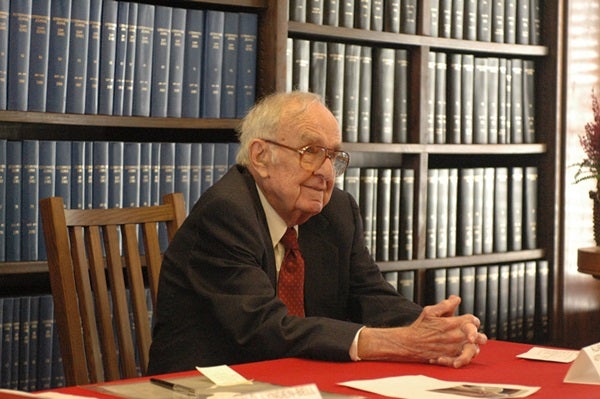Allan R. Sandage, Edwin Hubble’s former observing assistant and one of the most prominent astronomers of the past century, died November 13, 2010, at his home in San Gabriel, California, of pancreatic cancer.
Born in Iowa City, Iowa, June 18, 1926, Sandage grew up to define the fields of observational cosmology and extragalactic astronomy. He received his B.A. in 1948 from the University of Illinois and his Ph.D. from the California Institute of Technology in 1953, where he was the famous astronomer Walter Baade’s Ph.D. student in stellar evolution. During the early 1950s, he served as Edwin Hubble’s observing assistant at the Mount Wilson and Palomar observatories. Hubble, for whom the space telescope is named, discovered that the universe is larger than the Milky Way and that the cosmos is expanding.
Sandage joined the staff of the Carnegie Observatories in 1952 and, after Hubble’s death in 1953, became responsible for the cosmology program using telescopes at Mount Wilson and Palomar. His primary focus was to carry on Hubble’s work and determine the rate at which the universe is expanding, research he continued for 6 decades. Although he officially retired September 1, 1997, he was still actively working until August of this year.
During the course of his studies he made seminal contributions to dating the ages of stars and the expansion age of the universe, classifying galaxies, and understanding galaxy formation and evolution. He led the first major redshift — or distance — surveys of galaxies, from which he created a three-dimensional map to explore galaxy distribution and the dynamics of the nearby universe. Sandage was the first to recognize the existence of quasars without strong radio emission. Quasars are the brightest and most distant objects in the universe. He developed new techniques for observing, which affected a broad range of astronomical topics.
Sandage’s prolific work yielded honorary degrees from Yale University, University of Illinois, University of Chicago, University of Southern California, Miami University, Graceland College, and the University of Chile. He has also received numerous prestigious awards, including the Eddington Medal of the Royal Astronomical Society in 1963; the Pope Pius IX gold medal in 1966; the Elliot Cresson Medal of The Franklin Institute in 1973; the highest scientific award in the U.S., the National Medal of Science, in 1971; the Crafoord Prize of the Swedish Royal Academy of Sciences in 1991; and the Cosmology Prize of the Peter Gruber Foundation in 2000.
Sandage is survived by his wife, Mary, of San Gabriel, California, and two sons, David Sandage and John Sandage.
Allan R. Sandage, Edwin Hubble’s former observing assistant and one of the most prominent astronomers of the past century, died November 13, 2010, at his home in San Gabriel, California, of pancreatic cancer.
Born in Iowa City, Iowa, June 18, 1926, Sandage grew up to define the fields of observational cosmology and extragalactic astronomy. He received his B.A. in 1948 from the University of Illinois and his Ph.D. from the California Institute of Technology in 1953, where he was the famous astronomer Walter Baade’s Ph.D. student in stellar evolution. During the early 1950s, he served as Edwin Hubble’s observing assistant at the Mount Wilson and Palomar observatories. Hubble, for whom the space telescope is named, discovered that the universe is larger than the Milky Way and that the cosmos is expanding.
Sandage joined the staff of the Carnegie Observatories in 1952 and, after Hubble’s death in 1953, became responsible for the cosmology program using telescopes at Mount Wilson and Palomar. His primary focus was to carry on Hubble’s work and determine the rate at which the universe is expanding, research he continued for 6 decades. Although he officially retired September 1, 1997, he was still actively working until August of this year.
During the course of his studies he made seminal contributions to dating the ages of stars and the expansion age of the universe, classifying galaxies, and understanding galaxy formation and evolution. He led the first major redshift — or distance — surveys of galaxies, from which he created a three-dimensional map to explore galaxy distribution and the dynamics of the nearby universe. Sandage was the first to recognize the existence of quasars without strong radio emission. Quasars are the brightest and most distant objects in the universe. He developed new techniques for observing, which affected a broad range of astronomical topics.
Sandage’s prolific work yielded honorary degrees from Yale University, University of Illinois, University of Chicago, University of Southern California, Miami University, Graceland College, and the University of Chile. He has also received numerous prestigious awards, including the Eddington Medal of the Royal Astronomical Society in 1963; the Pope Pius IX gold medal in 1966; the Elliot Cresson Medal of The Franklin Institute in 1973; the highest scientific award in the U.S., the National Medal of Science, in 1971; the Crafoord Prize of the Swedish Royal Academy of Sciences in 1991; and the Cosmology Prize of the Peter Gruber Foundation in 2000.
Sandage is survived by his wife, Mary, of San Gabriel, California, and two sons, David Sandage and John Sandage.










